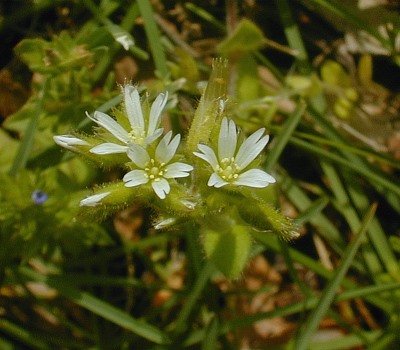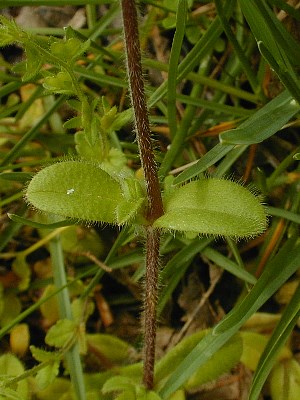Description: This plant is a winter or spring annual that becomes 4-10" tall. It has a small tuft of erect to ascending leafy stems; these stems are light green to dark purple, terete, and hairy. Along each stem, there are pairs of sessile opposite leaves at intervals. Individual leaves are up to ¾" long and about half as much across; they are medium green, bluntly ovate, broadly oblong, or obovate with smooth margins. Both the lower and upper surfaces of each leaf are covered with hairs. The hairs on the stems and leaves may have a sticky texture from minute glandular secretions.

Each stem
terminates in a dense cluster of flowers; in addition, individual or
small clusters of flowers may develop from the axils of the upper
leaves. Each small flower is about ¼" across, consisting of 5 white
petals, 5 green sepals, 10 stamens, and a pistil with 5 styles. The
tips of the petals are notched. The lanceolate sepals have long
forward-pointing hairs and membranous margins. The hairy pedicel of
each flower is no longer than 5 mm. (1/5") in length, even when it has
transformed into a seed capsule. The blooming period occurs from
mid-spring to early summer and lasts about 3-4 weeks. Each flower
transforms into a cylindrical seed capsule that is up to twice the
length of the persistent sepals. This seed capsule is membranous along
the sides and open at the apex, where there are 10 tiny teeth. At the
bottom of this capsule, there are several tiny seeds. Each seed is
obovoid or heart-shaped, somewhat flattened, and minutely pebbly on the
outer surface. The root system is shallow and fibrous. This plant
spreads by reseeding itself; it often forms colonies in favorable
habitats.

Cultivation:
This little weed prefers partial to full sun and moist to slightly dry
conditions. It is often found in soil containing loam, clay-loam, or
other material. This species can invade lawns to some extent.
Range & Habitat:
Glomerate
Mouse-Eared Chickweed is occasional throughout Illinois (see Distribution
Map), where it is not native. Habitats include openings in
rocky woodlands, grassy
meadows, lawns, pastures, fallow fields, roadsides, and waste ground.
Areas with a history of disturbance are preferred. This species is
native to Eurasia.
Faunal Associations:
The nectar and pollen of the flowers attract small bees (Halictid
& others) and flies (Syrphid & others). The
caterpillars of the moths Agrostis venerabilis
(Venerable Dart), Haematopis grataria (Chickweed
Geometer), and Lobocleta ossularia (Drab Brown
Wave) feed on chickweeds. Among vertebrate animals, the Mourning Dove
and various sparrows occasionally eat the seeds, while the foliage is
eaten by the Cottontail Rabbit and Woodchuck.
Photographic Location:
A lawn at a state park in west-central Indiana.
Comments:
The distinctive characteristic of this chickweed is its dense
cluster(s) of flowers. In particular, the pedicels of the flowers are
the same length or shorter than the sepals (5 mm. or less). Several
other species of chickweeds are similar in appearance, but at least
some of their pedicels exceed 5 mm. in length (particularly when their
flowers have transformed into seed capsules). The sepals of Glomerate
Mouse-Eared Chickweed are somewhat unusual because they are covered
with long forward-pointing hairs that may extend beyond their margins;
other species of chickweed have sepals with shorter hairs. In general,
the various species in the Cerastium genus are
called "Mouse-Eared Chickweeds" because of the shape and hairiness of
their leaves; these species usually have 10 stamens and 5 styles per
flower. A scientific synonym of Glomerate Mouse-Eared Chickweed is Cerastium
viscosum. Because of this defunct scientific name, this
species is sometimes called "Clammy Mouse-Eared Chickweed."